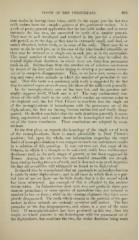Page 489 - My FlipBook
P. 489
TEETH OF THE VERTEBRATA. 499
true molar in having three lobes, while in the upper jaw the last two
milk molars have the complex pattern of the permanent molars. It is
a rule of pretty general application that the last milk molar, and in many
instances the last two, are succeeded by teeth of a simpler pattern.
They may be well developed and retained in the jaw for a consider-
able period, as in the dog, or they may be extremely small, and shed, or
rather absorbed, before birth, as in some of the seals. There may be as
many as six in each jaw, as in the case of the nine-banded armadillo, or
they may be reduced to a single one in each jaw, as in the marsupials.
The usual nundjer of milk molars is four in what may be called the
typical diphyodont dentition, in which there are forty-four permanent
teeth in all. Subtractions from this number are of conmion occurrence
by reason of the first milk molar failing to develop a permanent succes-
sor or its complete disappearance. This, as we have seen, occurs in the
dog and many other animals in which the number of premolars is nor-
mal. That this tooth is a persistent milk tooth is suggested by the fact
that its enamel organ arises
urally suggests itself. Which one is it? The very rudimentary con-
dition of the milk teeth in the seals, which reaches an extreme point in
the elephant seal, has led Prof. Flower to conclude that the single set
of the monophyodonts is homologous with the permanent set of the
diphyodonts, the first set having become rudimental and finally disap-
peared. He further concludes that the milk dentition generally is some-
thing superadded, and cannot therefore be homologized with the first
set of the lower vertebrates. These conclusions are adopted by many
authors.
In the first place, as regards the homology of the single set of teeth
of the monophyodonts, there is nuich plausibility in Prof Flower's
position but, u])on the whole, our information respecting the exact
;
limits of monophyodontism is too meagre to reach any satisfactory results
in a solution of this question. It may yet turn out that many of the
Cetacea, in which it is thought to be universal, really have rudimentary
deciduous teeth in the early stages of growth, as has been suggested by
Tomes. Among the edentates the nine-banded armadillo has already
been cited as having two sets of teeth, and it does not seem at all improba-
ble that all armadillos will ultimately be found to be diphyodont.
It should also be remembered that an approach to monophyodontism
is made in many diphyodonts ; and in all cases in which there is a par-
tial loss of one set there can be little doubt that it is the second which
has been subtracted. An example of this is afforded by the jn-obos-
cidean series. In Deinotherium there were two and probably three per-
manent premolars ; in some species of mastodons they are reduced in
number to two or three ; while in the existing elephants they have com-
pletely disappeared. The teeth which remain in the position of the pre-
molars in these animals are certainly persintent milk molars. The first
premolar of the dog, hippopotamus, and others is a case of the same
kind. If monophyodontism has been produced in this way, then the
single set which remains is not homologous with the permanent set of
the diphyodontSj but combines the two, the molar dentition being made


